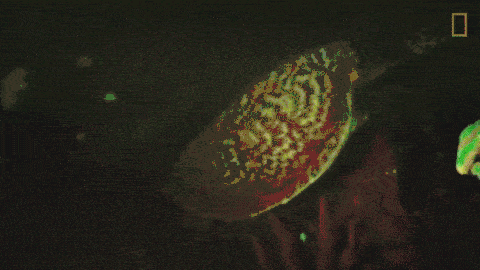“Hey, what did you find” “We found a bio-florescent turtle!”, a researcher triumphantly declared. David Gruber, a biologist at City University of New York, and colleagues made the find while diving in the Solomon Islands this July. Previously, researchers have found ever growing evidence of bio-luminescence and bio-fluorescence in the animal kingdom, from coral to seahorses, but this was the first time anyone has laid sight on a glowing reptile.
Glow in the dark animals
You can find bioluminescent life forms everywhere on the planet. On land, glowing species of fungus feed on rotting wood, creating the eerie nighttime phenomenon known as foxfire. Of course, the most famous luminescent creatures are fireflies. Glow worms are also insects — they’re the larvae of various species of flies and beetles. But the most glowing animals are found in the ocean, not on land. Most of these creatures live well bellow the water’s surface in the twilight or euphotic zone where sunlight barely creeps in. Some of it does, though. Since light is comprised of many wavelengths, some get absorbed by the sea water (red, orange and yellow) while other frequencies make it through (bluish-green). This light is absorbed by some luminescent creatures, then beamed back at 440 to 479 nanometers.
Although it takes many guises in nature, bioluminescence serves the three basic purposes of “finding food, finding mates and defending against predators,” says Edie Widder, co-founder, president and senior scientist at the Florida-based Ocean Research and Conservation Association (ORCA). It’s proven to be a good tactic seeing how scientists estimate 80 to 90 percent of deepwater, oceanic life has developed the ability to produce light.
In most cases bioluminescence is generated when a light-emitting molecule, called luciferin, chemically reacts with oxygen in the presence of an enzyme, called a luciferase or a photoprotein. The emitted light is called ‘cold light’ because it wastes little heat, much like an LED – just better. Biofluorescence is different from bioluminescence, though despite to the untrained eye it may seem the same. Bioluminescent animals produce their own light, while biofluorescent animals simple reflect glowing halos.
Gruber found the biofluorescent turtle completely by accident. When he and colleagues spotted the creature, it looked like an underwater UFO. Later, researchers managed to find other such turtles, called hawksbills, kept by some locals in captivity. After careful study, they found the animals glowed in red.

It’s believed the hawkbill evolved this ability for camouflage, which doesn’t sound right if you think about it. During the day, they’re very hard to spot, but the same at night too since the turtles hang out around coral which is florescent as well.
One might wonder what took so long to identify the turtles as florescent. Apparently, in shallow waters not enough blue light to create the “glow” effect. When you shine a blue light directly onto their shells, however, it glows in bright neon red and green. Unfortunately, there’s another reason why we’ve barely discovered the first biofluorescent reptile. Hawkbills are endangered and some of the rarest on the planet.
“Why is it that we know so little about these amazing animals?” Gruber asks. With renowned interest, maybe we’ll find out.







